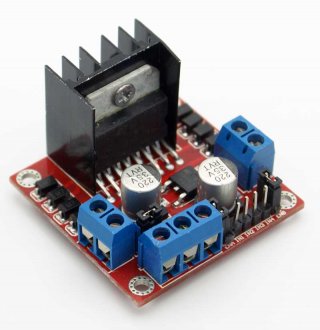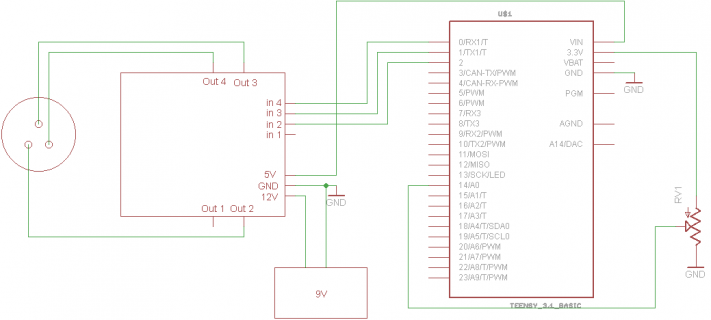I built a circuit to drive a small 3 phase using a teensy 3.1 and a L298N motor controller board.
I programmed the board to turn on the phases 1 at a time in sequential order (there are 3 wires coming from the motor).
Also programmed the led to change state every time the next phase came on.
I have a pot to control the speed.
All the connections to the teensy are.
Ground from the controller board.
5 Volts from the controller board to the Vin pin.
500 ohm pot hooked between the 3.3V pin and ground, with the center pin going to A0.
Output pins 0, 1, & 2 going to the inputs of the L298N board.
Usb is disconnected when being powered from the motor controller board.
When I power it up, the led flashes, the motor starts turning and I can control the speed with the pot.
I let the motor run for a minute or 2, then it just coasted to a stop and the led on the teensy was off.
I touched the teensy and the micro was hot.
I turned everything off and removed the teensy from the breadboard and plugged it into the usb and it had no life and started getting hot.
I checked the voltage on the 3.3 pin and it was about 1 volt.
I checked the voltage on the 5v output on the controller (the one I'm powering the teensy with) and it read 5.02V.
I also checked the voltage on the input pins (to make sure something on the board hadn't gone bad) and they all read around 0V.
I thought maybe something had just gone bad on the teensy, so I grabbed another one, programmed it and put it in the circuit.
I was able to power up the motor again and it ran for a minute or 2, then the same thing happened again.
This board also has no life and gets hot when plugged into the usb.
I have a couple of questions.
1st- do you have a warranty/repair service?
2nd- anybody have any clue as to what could be happening?
I want to do this project, but I don't want any more boards to die.
The pot is 500 ohms, so it should only be drawing about 7mA.
According to the datasheet, it only needs 2.3 volts on the input to turn on and has a maximum of 100uA going into the inputs (typical 30uA).
The inputs also don't need any type of protection (they are isolated from the load voltage).
Any help/ideas appreciated.
Jeff
I programmed the board to turn on the phases 1 at a time in sequential order (there are 3 wires coming from the motor).
Also programmed the led to change state every time the next phase came on.
I have a pot to control the speed.
All the connections to the teensy are.
Ground from the controller board.
5 Volts from the controller board to the Vin pin.
500 ohm pot hooked between the 3.3V pin and ground, with the center pin going to A0.
Output pins 0, 1, & 2 going to the inputs of the L298N board.
Usb is disconnected when being powered from the motor controller board.
When I power it up, the led flashes, the motor starts turning and I can control the speed with the pot.
I let the motor run for a minute or 2, then it just coasted to a stop and the led on the teensy was off.
I touched the teensy and the micro was hot.
I turned everything off and removed the teensy from the breadboard and plugged it into the usb and it had no life and started getting hot.
I checked the voltage on the 3.3 pin and it was about 1 volt.
I checked the voltage on the 5v output on the controller (the one I'm powering the teensy with) and it read 5.02V.
I also checked the voltage on the input pins (to make sure something on the board hadn't gone bad) and they all read around 0V.
I thought maybe something had just gone bad on the teensy, so I grabbed another one, programmed it and put it in the circuit.
I was able to power up the motor again and it ran for a minute or 2, then the same thing happened again.
This board also has no life and gets hot when plugged into the usb.
I have a couple of questions.
1st- do you have a warranty/repair service?
2nd- anybody have any clue as to what could be happening?
I want to do this project, but I don't want any more boards to die.
The pot is 500 ohms, so it should only be drawing about 7mA.
According to the datasheet, it only needs 2.3 volts on the input to turn on and has a maximum of 100uA going into the inputs (typical 30uA).
The inputs also don't need any type of protection (they are isolated from the load voltage).
Any help/ideas appreciated.
Jeff



